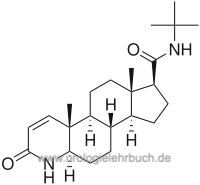You are here: Urology Textbook > Drugs in Urology > Finasteride
Finasteride: Mechanism, Side Effects and Dosage
Mechanism of Action of Finasteride
Finasteride is a synthetic steroid similar to testosterone; it leads to a competitive inhibition of the 5α-reductase 2 and 3. Among other things, 5α-reductase is responsible for converting testosterone into dihydrotestosterone (DHT); the further function of 5α-reductase on other steroids is still insufficiently understood. Dihydrotestosterone is the most potent natural androgen with effects on numerous organs, especially during fetal development. In adult men, inhibition of 5α-reductase is used to treat benign prostatic hyperplasia and androgenetic alopecia. In a direct comparison in BPH therapy, there are no significant differences between finasteride and dutasteride (Park et al., 2014); 5α-reductase inhibitors can be combined with alpha blockers to improve efficacy.
 |
Indications for Finasteride
- Benign prostate hyperplasia: lower urinary tract symptoms or bleeding due to significant BPH (>40 ml prostate volume). The inhibition of the 5α-reductase causes shrinkage of the prostate (7–13 ml in 12 months), improvement of IPSS and LUTS, stronger urinary flow (0,6–1,6 ml/s), lowers the risk of urinary retention (3% vs. 7%), hematuria or surgical interventions (5% vs. 10%) after five years of therapy (McConnell u.a., 1998). Finasteride can be combined with alpha blockers to improve its effectiveness.
- Androgenetic alopecia: finasteride stops hair loss and stimulates hair growth (Gupta et al., 2022).
Pharmacokinetics of Finasteride
Good oral absorption of finasteride, high plasma protein binding, the metabolites are excreted via the stool (60%) and urine (40%). Half-life 6–8 hours. No dose adjustment is necessary in chronic kidney disease (GFR >9 ml/min), experience in dialysis patients is not available.
Side Effects of Finasteride
Dihydrotestosterone is the most potent natural androgen with effects on numerous organs, especially during fetal development. Furthermore, the function of 5α-reductase on other steroids is poorly understood. Long-term use of finasteride can lead to serious side effects. The extent and frequency are controversial and underreported in the approval studies (Traish et al., 2020).
PSA concentration:
Finasteride reduces the PSA concentration by 50% within a year. The ratio fPSA/tPSA is not affected.
Prostate cancer:
The incidence of prostate cancer was reduced (25% compared to placebo) in long-term studies with 5α-reductase inhibitors. However, the rate of undifferentiated prostate carcinoma was higher in the verum group without an effect on overall survival (Goodman et al., 2019).
Sexual side effects:
Often reduced ejaculate volume, decreased libido, gynecomastia (1–2%), and erectile dysfunction (<2%). Infertility (reduced sperm count, worsening of OAT syndrome) is possible but usually only mild and temporary (Samplaski et al., 2013).
Neuropsychiatric side effects:
Neurosteroid interference increases the risk of depression, anxiety disorders, suicidality, and cognitive impairment (Giatti et al., 2024). The FDA and EMA have published warnings regarding neuropsychiatric side effects of finasteride.
Metabolic side effects:
Finasteride increases the risk of insulin resistance and metabolic syndrome.
Post-finasteride syndrome:
Sexual and neuropsychiatric side effects may persist in some patients even after discontinuation of finasteride (Giatti et al., 2024). The mechanism, extent, and frequency are controversial.
Other:
Rarely allergic skin reactions. Controversial: increased risk of breast cancer.
Drug Interactions with Finasteride
Clinically significant interactions with finasteride are not known.
Contraindications of Finasteride
- Children
- Women, pregnancy (risk of malformations).
- Caution in patients with intolerance, side effects, and desire to have children.
Dosage of Finasteride
5 mg finasteride orally once daily for treatment of BPH. For treatment of androgenetic alopecia, 1 mg finasteride orally once daily or topical finasteride preparations are prescribed.
| Urologic drugs | Index | Dutasteride |
Index: 1–9 A B C D E F G H I J K L M N O P Q R S T U V W X Y Z
References
Andriole u.a. 2004 ANDRIOLE, G. ; BRUCHOVSKY,
N. ; CHUNG, L. W. ; MATSUMOTO, A. M. ; RITTMASTER,
R. ; ROEHRBORN, C. ; RUSSELL, D. ; TINDALL, D.:
Dihydrotestosterone and the prostate: the scientific rationale for
5alpha-reductase inhibitors in the treatment of benign prostatic hyperplasia.
In: J Urol
172 (2004), Nr. 4 Pt 1, S. 1399–403
Chapple 2004 CHAPPLE, C. R.:
Pharmacological therapy of benign prostatic hyperplasia/lower urinary
tract symptoms: an overview for the practising clinician.
In: BJU Int
94 (2004), Nr. 5, S. 738–44
J. M. Hirshburg, P. A. Kelsey, C. A. Therrien, A. C. Gavino, and J. S. Reichenberg, “Adverse Effects and Safety of 5-alpha Reductase Inhibitors (Finasteride, Dutasteride): A Systematic Review.,” J Clin Aesthet Dermatol., vol. 9, no. 7, pp. 56–62, 2016.
Giatti S, Diviccaro S, Cioffi L, Cosimo Melcangi R. Post-Finasteride Syndrome And Post-Ssri Sexual Dysfunction: Two Clinical Conditions Apparently Distant, But Very Close. Front Neuroendocrinol. 2024 Jan;72:101114. doi: 10.1016/j.yfrne.2023.101114.
Gupta AK, Talukder M, Williams G. Comparison of oral minoxidil, finasteride, and dutasteride for treating androgenetic alopecia. J Dermatolog Treat. 2022 Nov;33(7):2946-2962. doi: 10.1080/09546634.2022.2109567
J. D. McConnell et al., “The effect of finasteride on the risk of acute urinary retention and the need for surgical treatment among men with benign prostatic hyperplasia. Finasteride Long-Term Efficacy and Safety Study Group,” vol. 338, no. 9, pp. 557–63, 1998.
Samplaski MK, Lo K, Grober E, Jarvi K. Finasteride use in the male infertility population: effects on semen and hormone parameters. Fertil Steril. 2013 Dec;100(6):1542-6. doi: 10.1016/j.fertnstert.2013.07.2000. Epub 2013 Sep 4. PMID: 24012200.
A. M. Traish, “Health Risks Associated with Long-Term Finasteride and Dutasteride Use: It’s Time to Sound the Alarm.,” World J Mens Health., vol. 38, no. 3, pp. 323–337, 2020, doi: 10.5534/wjmh.200012.
 Deutsche Version: Finasterid
Deutsche Version: Finasterid